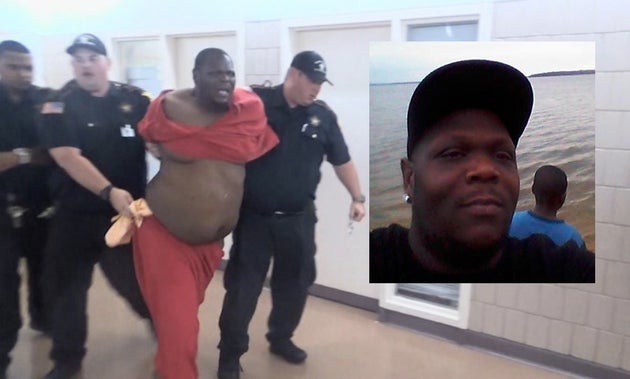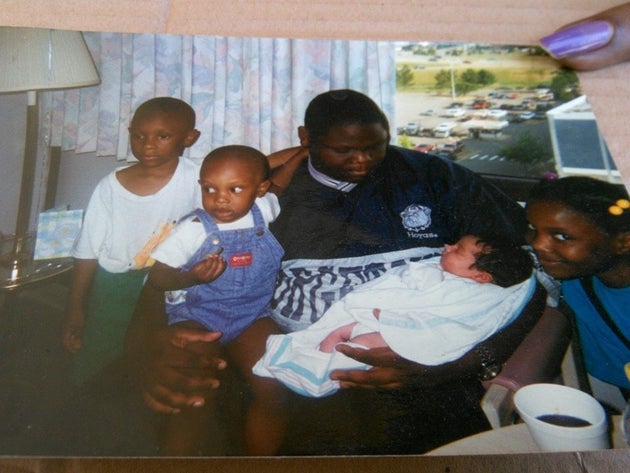National media icon, The Huffington Post, is reporting on a shocking jail death case being handled by the attorneys at Budge & Heipt. From The Huffington Post, October 5, 2016:
‘I Can’t Breathe’: Disturbing Video Shows Father Of Four Begging Guards For Help Before He Died In Jail
Michael Sabbie, 35, died of “natural” causes after being pepper-sprayed and repeatedly asking employees at a privately run jail for help.

“I can’t breathe.”
Michael Sabbie ― a 35-year-old stay-at-home father of four ― said it after five guards piled on top of him inside the Bi State Jail, a facility that sits directly on the border between Texas and Arkansas and is run by a for-profit company.
“I can’t breathe.” Sabbie ― who packed his kids’ lunches, drove them to and from school, and carted them around to their after-school activities ― said it again after a sixth officer pepper-sprayed him as he lay on the concrete floor.
“I can’t breathe, sir. Please! Please!” Sabbie ― who wrote a Facebook post thanking God for his kids just hours before his arrest ― said it again as guards held him up against a wall outside of the nurse’s station.
“I can’t breathe,” Sabbie said again after he was forced into the shower. “I can’t breathe,” Sabbie repeated, echoing the final words of another black father, 43-year-old Eric Garner, who died in New York in July 2014 as the result of an officer’s illegal chokehold.
A guard threatened to pepper-spray Sabbie again. “I’m sorry,” Sabbie said, hoping to avoid being hit with painful chemical agent a second time. “I’m sorry. I’m sorry.” Then Sabbie collapsed. The guards, paid a starting rate of $10 an hour, apparently thought he was faking it. They took him to a cell.
“Can’t breathe,” Sabbie said as guards removed his handcuffs and left him on the floor of the cell overnight. Sabbie, who at that point had been in custody for roughly 48 hours, was dead by the morning.

The basic details of Sabbie’s death, one of more than 800 jail deaths counted by The Huffington Post in the year after Sandra Bland died in jail on July 13, 2015, wouldn’t normally raise much suspicion. The initial news reports said that Sabbie, who was arrested on a domestic assault charge, was found “unresponsive” on the morning of July 22, 2015, suggesting he died in his sleep. A medical examiner ― noting Sabbie’s obesity and that he had significant heart muscle damage ― deemed his death “natural,” a label that implies it was an unavoidable tragedy. Those circumstances wouldn’t make Sabbie’s death terribly unique: Heart disease killed an average of 226 jail inmates a year from 2000 until 2013, making it the leading cause of jail deaths after suicides.
But calling Sabbie’s death “natural” obscures more than it illuminates, and would hide the failures that very likely could have prevented his death. A quick internal investigation might have absolved jail employees of any wrongdoing. But in Sabbie’s case, there’s video.
“If you just looked at the cause of death, you would think that Michael died of some sort of hypertensive heart condition, and that may be true,” said Erik J. Heipt, one of the attorneys representing the Sabbie family. “But if we didn’t have a video, we’d never know that he had been begging for help due to his shortness of breath and inability to breathe. We’d never know that he said ‘I can’t breathe’ 19 times in the nine minutes that we hear in that video.”
Watch the full video here.
Heipt and his law partner, Edwin Budge, regularly represent families of individuals who have died in jails across the country. But this video is “without a doubt among one of the most outrageous,” Budge said.
“Clearly he’s a person in a state of medical crisis, in medical need, asking for help, and the response to his essentially pleas for medical help is inhumane, which is a term I don’t use lightly,” Budge said.
Preventable deaths being labeled as “natural” is a “common phenomenon” and a “huge problem” in jails across the country, said David C. Fathi, the director of the ACLU’s National Prison Project.
“We often find that someone’s death is characterized as ‘natural causes’ ― maybe it was cancer, maybe it was heart disease,” Fathi said. “But if you look at the medical record, you often find egregious neglect and denial of care. If someone dies of cancer that went totally untreated, is that death from natural causes?”

Sabbie was arrested on July 19, 2015, after getting into an argument with his wife over money, according to a police report. Sabbie’s wife told an officer that he threatened her before getting out of the car and walking away. Another officer located Sabbie, who denied threatening his wife. Due to the alleged threat, Sabbie was arrested for third-degree assault on a household or family member, a misdemeanor.
Sabbie was taken to the Bi State Jail, a facility with 164 beds that housed 134 individuals as of this week. The for-profit company LaSalle Corrections has run the facility since 2013, when a previous company backed out because it reportedly could not turn a profit. Governments pay just $39.50 per day to house inmates at the Bi State lockup and $46.50 per day to place them at the Bowie County facility, a nearby facility LaSalle Corrections also runs. (The company that backed out of the previous contract submitted a competing bid of $56.25 per inmate per day.) Under the contract with Bowie County, LaSalle Corrections absorbs the cost of medical services and also indemnifies the county against any claims from inmates or their families.
The Bowie County facility has agreements with local surrounding counties to house their inmates, which the Bowie County Sheriff has said “helps us to lower the costs” of detaining the county’s own detainees, and jail revenue is “one of the largest portions of Bowie County’s budget,” according to a local news report. A job listing for a position at the Bowie County Correctional Center says pay is $10 per hour, and that the position requires “zero experience as a correctional officer.” As of this July, the facilities were reportedly shorthanded and seeking to fill dozens of positions.
With a population of just 134, the Bi State Jail is one of the smallest jails in the country that had two reported deaths in The Huffington Post’s jail deaths project, which looked at deaths between July 13, 2015, and July 13, 2016. There were two additional deaths at the nearby Bowie County Correctional Center, which has 748 beds and a population of 674 as of this week. Together, the LaSalle facilities had four deaths in a single year, with a joint population of just 808. Other jails that reported four deaths in the year HuffPost examined had populations double, triple and even quadruple that.
Matthew Campbell, who is representing the family of another inmate who died in the Bi State Jail, said the facility is “by far the least secure jail” he’s ever been in. He said he was able to walk in with a briefcase without being searched or showing identification.
“The guy behind the big glass window doesn’t have me sign in, doesn’t ask for ID. There’s no metal detector, he doesn’t check my bag, buzzes me into the attorney meeting room,” Campbell said. “It could have been a briefcase full of cocaine and guns, and I could have left it there in the room and nobody would have been any the wiser.”
At about 3:30 a.m. on July 20, less than 12 hours after his arrest, Sabbie told jail staff he was having difficulty breathing and could not breathe while lying down. A nurse treated him for a low level of oxygen in his blood, and advised him to sit up if he had trouble breathing.
The next day, July 21 at 10:30 a.m., Sabbie was found on the floor of his cell and taken to the nurse’s station. He said once again that he couldn’t breathe and that he believed he had pneumonia. But a nurse cleared him to go back to his cell, which frustrated Sabbie. “So [y’all] aren’t going to help?” he asked, according to police records. He began walking back to his cell, but fell on the floor on his way back and required assistance. The nurse, Tiffany Venable, said she had seen no signs or symptoms of pneumonia during the morning appointment. She told an investigator she completed a medical form for this visit, but believed she placed it in the wrong file.
Sabbie had a court appearance that afternoon, during which he pleaded not guilty and had his bond set at $2,500. A court bailiff said he observed Sabbie “sweating very heavily and coughing.” The judge also saw that Sabbie was having trouble breathing, and suggested Sabbie might have asthma or bronchitis. Sabbie said in court that he had been spitting up blood and needed to go to the hospital.
After the court appearance, Sabbie and a group of other detainees were taken back to the jail at about 4:15 p.m. This is where the video kicks in, and we see that Sabbie stopped to lean against a wall.
Officer Clint Brown walked over to Sabbie. Brown claimed Sabbie wanted to use the phone in the booking desk, but Brown said he had to go back to his cell. He claimed Sabbie turned aggressively toward him, so he grabbed him. Other officers soon assisted.
Lt. Nathaniel Johnson, who earlier in the day had taken Sabbie to the nurse because he had difficulty breathing, pepper-sprayed Sabbie directly in the face, just as he said, “I can’t breathe.”
Venable, the nurse who saw Sabbie earlier in the morning and had been on duty since 5 a.m., witnessed the guards use force against Sabbie, and then evaluated him briefly in her office. She didn’t fill out a form, but said she believed his complaints were a normal reaction to pepper spray.
“Ms. Venable said she wanted to get off work on time because she had to get her daughter to a pitching lesson,” one police report states. “She said she was going to complete one this morning when she came into work but learned that Mr. Sabbie had passed away.”
Heipt, one of the lawyers for the Sabbie family, said they believe that Sabbie had pulmonary edema, or excess fluid in his lungs caused by a heart condition. It’s a medical emergency, but treatable and should have been detected with a proper evaluation, Heipt said. The State Crime Laboratory’s Medical Examiner Division found that Sabbie died of “hypertensive arteriosclerotic cardiovascular disease,” and claimed that the altercation “played a minimal role in the decedent’s death, and may not have contributed at all to his death.”

Correctional Officer Simone Nash was charged with keeping an eye on Sabbie overnight. She was required to do cell safety checks on all her pods and cells every 30 minutes, as well as a count four times each shift. Although her records indicated that the guard did those 30-minute checks, she admitted that “not all the checks were done and they were only documented,” according to a Texarkana Police report. Nash admitted she “didn’t consistently enter and check the cells inside the pods during every one of the 30 minute checks” as required, according to the report. During her counts, she said that while Sabbie never responded to her during the counts, she claims she saw him breathing.
LaSalle Corrections employees were still not conducting proper face-to-face observations on July 18, 2016, nearly a year after Sabbie’s death, according to the Texas Commission on Jail Standards, which performed the inspection after the July 1, 2016, death of Morgan Angerbauer. Twenty-year-old Angerbauer, whose family is represented by Campbell, was diabetic, and jail nurse Brittany Johnson was arrested in August and charged with negligent homicide in connection with her death. (In a similar case, a former Oklahoma guard was indicted on a federal civil rights charge this week for allegedly ignoring the medical needs of a diabetic detainee who died in 2013. It is rare for corrections officials to face such charges for exhibiting “deliberate indifference” to the medical needs of inmates.)
Heipt, who is also representing the family of a man who died of thirst in a jail run by prominent Donald Trump supporter and Milwaukee County Sheriff David Clarke, said it’s only recently that there has been public attention on jail deaths. Local media outlets sometimes only cover a “sham investigation” conducted by local officials investigating themselves before moving on.
“This is not a tin-foil hat conspiracy; it happens all the time,” Heipt said. “The jail or the county investigates itself, inmates aren’t interviewed, medical records are not reviewed, video recordings are lost or destroyed, and medical examiners who are in charge of determining the cause of death are not given complete information, and so the cause of death is either undetermined, wrong, or doesn’t tell the whole picture.
“The American public has no idea what’s taking place, and because of the lack of public awareness, there’s a corresponding lack of public outrage,” he added. “So politicians on the local and national level have ignored it. Consequently, jails are understaffed and underfunded, money is saved by denying medications and medical care. Funding issues also lead to inexperienced and unqualified corrections officers being hired, as well as a lack of training.”
[Related Story: Here’s How To Cover Jail Deaths]
Sabbie was “cold to the touch” when guards eventually entered his cell, according to documents. The voicemail of the warden, Robert Page, was full when HuffPost reached out for comment this week. He did not respond to a message left with an employee, nor did an official at LaSalle Corrections’ corporate office in Texas.
In a statement, the Sabbie family said they “cannot conceive of how something like this could happen to an American citizen” like Sabbie.
“He was treated as if his life did not matter,” the family said in a statement issued through their lawyers. “Most of all they want justice and accountability and to make sure that this doesn’t happen again.”

“I can’t put into words how devastated my children and I are after the loss of Michael,” Sabbie’s wife Teresa said in a statement. “He was my backbone and best friend. My children lost a wonderful father who wanted the best for his family. A piece of our heart is gone, and I pray to God for justice. This was a tragedy that should never have happened.”
The Department of Justice informed Teresa on Aug. 1, 2016, that it would not be prosecuting anyone in connection with her husband’s death.
“After careful consideration, we concluded that the evidence does not establish a prosecutable violation of the federal criminal civil rights statutes,” Paige Fitzgerald, acting principal deputy chief of the criminal section of DOJ’s Civil Rights Division, wrote in the letter. “Please accept or [sic] condolences on your lost [sic].”


